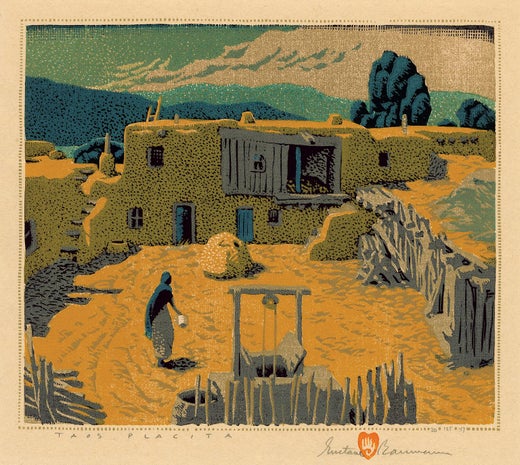Gustave Baumann“Taos Placita” Color Woodblock Print numbered II 82/125 by Gustave Baumanncirca 1940's
circa 1940's
About the Item
- Creator:Gustave Baumann (1881-1971, American, German)
- Creation Year:circa 1940's
- Dimensions:Height: 19.5 in (49.53 cm)Width: 21 in (53.34 cm)Depth: 1 in (2.54 cm)
- Medium:
- Movement & Style:
- Period:
- Condition:
- Gallery Location:Santa Monica, CA
- Reference Number:Seller: 77591stDibs: LU52531572963
Gustave Baumann
Gustave Baumann was born in Magdeburg, Germany, on June 27, 1881. Baumann immigrated to the USA as a child. He grew up in Chicago but became curious about New Mexico. He visited friends there in 1917 and settled in Santa Fe in 1918. He spent over 50 years there, where he participated in the art community. He created woodblocks from which he made prints and also became a carver of saints and marionettes, working with the Marionette Theatre. Baumann also created numerous paintings in bright colors. His woodcut subjects are church figures, scenes of sacred Indian pictographs and landscapes, including the Grand Canyon. During the 1930s, Baumann was a Works Progress Administration co-ordinator for Santa Fe. He died in Santa Fe on October 8, 1971.
You May Also Like
Late 19th Century Naturalistic Landscape Prints
Woodcut
1850s Naturalistic Figurative Prints
Paper, Ink, Woodcut
2010s Naturalistic Landscape Prints
Woodcut
1930s Naturalistic Landscape Prints
Paper
Mid-19th Century Naturalistic Animal Prints
Lithograph
Early 18th Century Naturalistic Still-life Prints
Engraving
Mid-19th Century Naturalistic Animal Prints
Lithograph
Mid-19th Century Naturalistic Animal Prints
Lithograph
Mid-19th Century Naturalistic Animal Prints
Lithograph
Mid-19th Century Naturalistic Animal Prints
Lithograph
